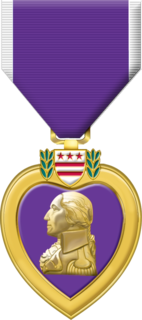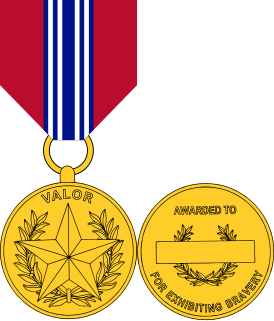
The Purple Heart (PH) is a United States military decoration awarded in the name of the President to those wounded or killed while serving, on or after April 5, 1917, with the U.S. military. With its forerunner, the Badge of Military Merit, which took the form of a heart made of purple cloth, the Purple Heart is the oldest military award still given to U.S. military members – the only earlier award being the obsolete Fidelity Medallion. The National Purple Heart Hall of Honor is located in New Windsor, New York.
The Commendation Medal is a mid-level United States military decoration presented for sustained acts of heroism or meritorious service. Each branch of the United States Armed Forces issues its own version of the Commendation Medal, with a fifth version existing for acts of joint military service performed under the Department of Defense.

The Prisoner of War Medal is a military award of the United States Armed Forces which was authorized by Congress and signed into law by President Ronald Reagan on 8 November 1985. The United States Code citation for the POW Medal statute is 10 U.S.C. § 1128.
The Combat Action Ribbon, is a high precedence United States Navy, United States Coast Guard, and United States Marine Corps military decoration awarded to United States sea service members "who have actively participated in ground or surface combat."

The Defense Meritorious Service Medal (DMSM) is an award bestowed upon members of the United States military by the United States Department of Defense. In the order of precedence of the United States Armed Forces, it is worn between the Purple Heart and the Meritorious Service Medal. The medal is awarded in the name of the Secretary of Defense to members of the Armed Forces who, while serving in a joint activity, distinguish themselves by non-combat outstanding achievement or meritorious service, but not of a degree to warrant award of the Defense Superior Service Medal.

The Republic of Vietnam Campaign Medal, also known as the Vietnam Campaign Medal, is a South Vietnamese military campaign medal which was created in 1949, and awarded to French military personnel during the First Indochina War. During the Vietnam War, the South Vietnamese government awarded the Republic of Vietnam Campaign Medal with Device to members of the South Vietnamese military for wartime service and on March 24, 1966, to members of the U.S. military for support of operations in Vietnam. In May 1966, other allied foreign military personnel became eligible for the award.

The Iraq Campaign Medal (ICM) is a military award of the United States Armed Forces which was created by Executive Order 13363 of U.S. President George W. Bush on 29 November 2004, and became available for general distribution in June 2005. The medal was designed by the U.S. Army Institute of Heraldry and was awarded during the Iraq War, from 19 March 2003 to 31 December 2011.

The Global War on Terrorism Service Medal (GWOT-SM) is a military award of the United States Armed Forces which was created through Executive Order 13289 on 12 March 2003, by President George W. Bush. The medal recognizes those military service members who have supported operations to counter terrorism in the War on Terror from 11 September 2001, to a date yet to be determined.
The NATO Medal is an international military decoration which is awarded to various militaries of the world under the authority of the North Atlantic Treaty Organization (NATO). It is manufactured by Eekelers-Centini Intl, of Hemiksem, Belgium.

The Meritorious Public Service Medal formerly the Outstanding Civilian Service Award is the third highest honor within the public service awards scheme of the Department of the Army that can be awarded to a private citizen.
The United States Department of State, like other agencies of the U.S. federal government, gives civilian decorations for outstanding service, sacrifice, or heroism. The criteria for the awards are set down in 3 FAM 4820 - Foreign Affairs Manual, 3 FAM - Personnel, section 3 FAM 4800 Department Awards Program.

The Armed Forces Civilian Service Medal (AFCSM) is established to recognize the contributions and accomplishments of the U.S. Department of Defense civilian workforce who directly support the military forces, when those members are engaged in military operations of a prolonged peacekeeping or humanitarian nature. The AFCSM symbolizes the importance the Department of Defense attaches to civilian service and recognizes the value of civilian service in helping to accomplish the U.S. Government's objectives. This award honors those employees who support designated operations under the same or similar conditions as U.S. military members, thereby strengthening the partnership between the civilian services and uniformed services.

The Secretary of Defense Medal for the Global War on Terrorism or Global War on Terrorism Civilian Service Medal is a medal awarded by the United States Department of Defense. It was authorized on August 9, 2007, but may be awarded for expeditionary service in a Global War on Terrorism mission in a combat zone on or after September 11, 2001, until a date to be determined.

The Thomas Jefferson Star for Foreign Service is an award of the United States Department of State. It is presented to employees of State, USAID, and civilian contractors assigned to diplomatic and consular facilities for events that lead to death or serious illness or injury. It is roughly comparable to the U.S. military's Purple Heart, but since the criteria for the award is so strict, nearly all of them are awarded posthumously.

The Secretary of the Army Award for Valor was established 15 April 2002, to acknowledge acts of heroism or bravery connected with an Army employee or Army activity, or that in some way benefits the Army. The performance of the act must be evidenced by voluntary action above and beyond the call of duty. The equivalent military decoration for this award is the Soldier's Medal.

The Office of the Secretary of the Defense Medal for Valor is the highest civilian award for valor presented by the United States Department of Defense. Created in 2001 in the aftermath of the September 11 attacks, the medal recognizes government employees and private citizens who perform an act of heroism or sacrifice, with voluntary risk to their personal safety in the face of danger.

The Distinguished Warfare Medal was a planned United States military decoration announced by former U.S. Secretary of Defense Leon Panetta on 13 February 2013. It would have been the first U.S. combat-related award to be created since the Bronze Star Medal in 1944. The blue, red and white-ribboned medal was to be awarded to individuals for "extraordinary achievement" related to a military operation occurring after 11 September 2001. It was intended to recognize military achievement in cyberwarfare or combat drone operations for actions that did not include valor in combat.

The Coast Guard Cross (CGC) is the United States Coast Guard's second highest military decoration for Coast Guardsmen who distinguish themselves extraordinary heroism in combat with an armed enemy force. Established by Act of Congress on 15 October 2010, it is intended to recognize members of the United States Coast Guard for extraordinary heroism in action. Coast Guard members serving under the Department of the Navy would be eligible for the Navy Cross. This medal, though approved, has not yet been awarded. By virtue of having never been awarded, it is the rarest United States military award.

The DEA Purple Heart Award is an award given by the United States Drug Enforcement Administration to honor individuals who had lost their lives or been seriously injured enforcing the drug laws of the United States.
The Remote Combat Effects Campaign Medal (RCECM) is a United States Air Force campaign medal established on 22 May 2019. The medal recognizes air force personnel, "in non-deployed status who directly participated in a U.S. Department of Defense (DoD) combat operation from a remote location.















